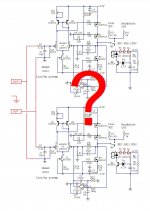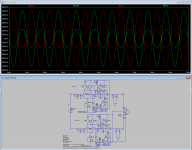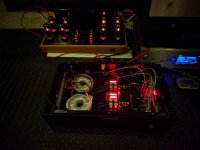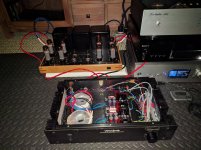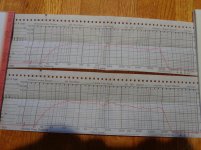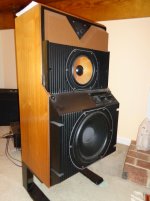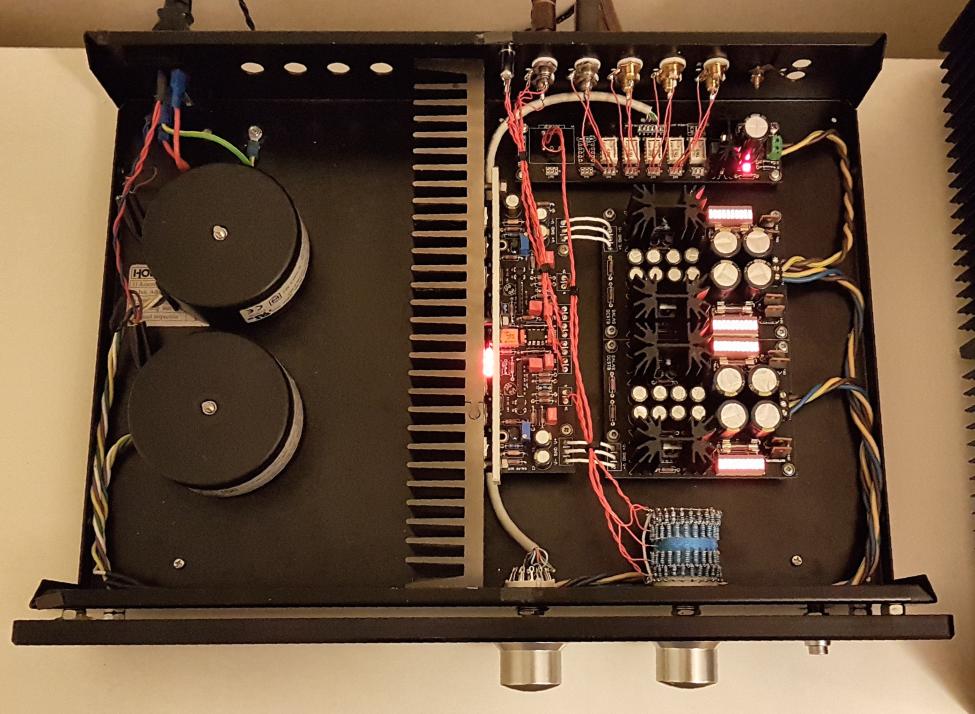I'm using older NHT 2.9's a 4 way design. The front of the speakers is angled towards the listening position. The woofers are mounted low on the inside side of the cabinets. They are 3 meters apart with their back 6 inches from the rear wall. My listening position is 4.5 meters in front of them. The flooring is carpeting, ceilings and walls are dry wall covering how wall framing.
I'm happy with the sound, I don't listen to a lot of Rock, mostly jazz, lots of vocals, piano. Some classical, lots of afro-latin music.
Those are very good speakers. Meant for near wall placement. Thus producing more early reflections than usual too. Combine that with a domestic room, not an $$ absorption/diffusion etc. treated studio control room, and a 4.5m listening distance... Impossible to compete in perceived detail with your close to ear coupled 1k$ Amazon priced Fostex headphone. Not only the room thing perplexes the loudspeakers situation, but the headphone is a full range single point source too, in other words coherent. Multi-way speakers need combine several wave launch geometrically broken points via time domain further intervening crossover circuits and also have cabinet edges that diffract. On the other hand, headphones presentation is spatially non natural unless listening to binaural recordings that are fantastic but weird as they usually put us inside the orchestra, not facing it from some distance. Try Chesky's Ultimate Headphone Demonstration Disc. Not to talk about how more spectacularly weird the immersion feeling gets with binaural surround demo sketches like this classic one: Virtual Barber Shop
Also this old review and measurement comment below, maybe explains why you preferred a 50k volume pot value that makes for a warmer sound:
"TJN also commented on the NHT 2.9's highs as sounding "a bit bright, with a slight bite to the treble." Fig.4 does reveal that there is a smooth rising trend apparent on-axis from the midrange to 12kHz or so, broken by some extra energy in the low treble... The 2.9's slight tendency to brightness will be exaggerated if it is positioned close to hard, reflective outside walls."
NHT 2.9 loudspeaker Measurements part 2 | Stereophile.com
Hello,
Me and my obsessions again... I hope I'm not being boring.
Trying to give a differential input to my DCG3 - a doubled build - I thought to test the circuit in post #61 of this thread A simplified universal differential or single ended phono preamp But this gave me another idea. To demonstrate it I had to cannibalize Salas' schematic, sorry. The idea is to provide the inputs of DCG3 with something to amplify while the source signal faces a balanced impedance. Would this work at all?
Me and my obsessions again... I hope I'm not being boring.
Trying to give a differential input to my DCG3 - a doubled build - I thought to test the circuit in post #61 of this thread A simplified universal differential or single ended phono preamp But this gave me another idea. To demonstrate it I had to cannibalize Salas' schematic, sorry. The idea is to provide the inputs of DCG3 with something to amplify while the source signal faces a balanced impedance. Would this work at all?
Attachments
It looks like shorting both differential input signal lines to ground. If both phases dcg3 amps were floating it would have been feasible I guess.
Salas, thanks for reply! The meaning behind all this is to isolate the source ground from DCG3 ground. What we would call "XLR pin1 to chassis". In the schematic I posted the grounds are supposed to be floating. I just don't know if they should be separated or connected together and in any case not connected to source ground.
In your schematic, I assume that pin1 problem is addressed but the whole DCG3 works as an input stage to the final opamp?
In your schematic, I assume that pin1 problem is addressed but the whole DCG3 works as an input stage to the final opamp?
I put a final op amp there to can also check recombination to SE. Normally the two amplified phases would just continue to feed a balanced input power amplifier.
Salas, thank you for going the extra distance to enlighten us audio enthusiasts.
I'm very satisfied with the music listening options I have now.
The DCG3 is an excellent line preamplifier and having a headphones output is a big plus.
I have achieve more than what I was looking for a few months back.
The NHT's are a great value if one is looking for a full range detailed sound.
I can also share that the DCG3 works great with valve amplification. Sometimes when I want more reverb, mellow highs and don't care much for strong bass definition I'll will plug in my RM9-II. Very enjoyable as well.
Thank you again for all the help and education.
Best regards.
I'm very satisfied with the music listening options I have now.
The DCG3 is an excellent line preamplifier and having a headphones output is a big plus.
I have achieve more than what I was looking for a few months back.
The NHT's are a great value if one is looking for a full range detailed sound.
I can also share that the DCG3 works great with valve amplification. Sometimes when I want more reverb, mellow highs and don't care much for strong bass definition I'll will plug in my RM9-II. Very enjoyable as well.
Thank you again for all the help and education.
Best regards.
Attachments
I put a final op amp there to can also check recombination to SE. Normally the two amplified phases would just continue to feed a balanced input power amplifier.
OK I understand it now. So, I only need to disconnect the ground wire from the input XLR as the rest is exactly what I have at the moment. I'll test it ASAP. Thanks again!
DCG3 with Diotec 327-40 mod
I bought 200 of the German Diotec 327-40 from a source on Ebay. Sorting indicated a range in hfe from 358 to 408, with several greater than 400. This is with a new MM and a new battery. Another MM showed 438 as the high one and the all component tester thingie sold on Ebay showed 379 for the same. Anyway, I got 8 exact matches of 406 hfe at around 67F referencing the first tester mentioned and I tested the matching five separate times. I also checked the eight 560C’s that were removed which TeaBag had sent me. Using the same tester and similar conditions the 560’s measured from 420 to 428. Tea’s sets were marked as 436, 440. So on average the 560’s had 19 higher hfe then the 327’s that I put in.
After a suitable burning in of around twenty hours, playing music at full volume into turned off power amps, I started some serious listening with speakers only, no headphones.. The tonality of the violin has changed. It is lighter, and more extended. It was as if the violinist had refined his/her style and was playing with a less heavy hand. Clearer vibrato. The surprise to me was the improvement in clarity of the piano notes especially the lower ones. Not a subtle but significant improvement. Listen to a softly struck note and you can hear the difference. Massed instruments also sounded clearer. Brasses, woodwinds, male and female voices all sounded clearer without any apparent loss of body and weight of the music. Transient speed gave the impression of being even faster because the notes were clearer.
Summing up, I’d say that the overall sound is clearer and somewhat brighter and nothing has been lost, only enhanced. And it’s more enjoyable. You need to burn it in for at least twenty hours. I found some harshness especially in the highs and a lack of smoothness before I let it burn in.
I noticed that in some recordings, for example, a violin concerto where the artist usually performs in the front and center of the orchestra that the artist seemed to be a bit further forward and a bit higher relative to the orchestra than I remember. I have not listened enough to be conclusive about this but perhaps there is slightly better focusing. Any thoughts? No other changes were made.
Subjectively it appears that the H2/H3 balance is slightly changed. Salas, any chance you have run an FFT comparing the DCG3 with the 560 vs 327?
With this mod, you have certainly raised the bar! Thank you!
nash
I bought 200 of the German Diotec 327-40 from a source on Ebay. Sorting indicated a range in hfe from 358 to 408, with several greater than 400. This is with a new MM and a new battery. Another MM showed 438 as the high one and the all component tester thingie sold on Ebay showed 379 for the same. Anyway, I got 8 exact matches of 406 hfe at around 67F referencing the first tester mentioned and I tested the matching five separate times. I also checked the eight 560C’s that were removed which TeaBag had sent me. Using the same tester and similar conditions the 560’s measured from 420 to 428. Tea’s sets were marked as 436, 440. So on average the 560’s had 19 higher hfe then the 327’s that I put in.
After a suitable burning in of around twenty hours, playing music at full volume into turned off power amps, I started some serious listening with speakers only, no headphones.. The tonality of the violin has changed. It is lighter, and more extended. It was as if the violinist had refined his/her style and was playing with a less heavy hand. Clearer vibrato. The surprise to me was the improvement in clarity of the piano notes especially the lower ones. Not a subtle but significant improvement. Listen to a softly struck note and you can hear the difference. Massed instruments also sounded clearer. Brasses, woodwinds, male and female voices all sounded clearer without any apparent loss of body and weight of the music. Transient speed gave the impression of being even faster because the notes were clearer.
Summing up, I’d say that the overall sound is clearer and somewhat brighter and nothing has been lost, only enhanced. And it’s more enjoyable. You need to burn it in for at least twenty hours. I found some harshness especially in the highs and a lack of smoothness before I let it burn in.
I noticed that in some recordings, for example, a violin concerto where the artist usually performs in the front and center of the orchestra that the artist seemed to be a bit further forward and a bit higher relative to the orchestra than I remember. I have not listened enough to be conclusive about this but perhaps there is slightly better focusing. Any thoughts? No other changes were made.
Subjectively it appears that the H2/H3 balance is slightly changed. Salas, any chance you have run an FFT comparing the DCG3 with the 560 vs 327?
With this mod, you have certainly raised the bar! Thank you!
nash
I bought 200 of the German Diotec 327-40 from a source on Ebay. Sorting indicated a range in hfe from 358 to 408, with several greater than 400. This is with a new MM and a new battery. Another MM showed 438 as the high one and the all component tester thingie sold on Ebay showed 379 for the same. Anyway, I got 8 exact matches of 406 hfe at around 67F referencing the first tester mentioned and I tested the matching five separate times. I also checked the eight 560C’s that were removed which TeaBag had sent me. Using the same tester and similar conditions the 560’s measured from 420 to 428. Tea’s sets were marked as 436, 440. So on average the 560’s had 19 higher hfe then the 327’s that I put in.
After a suitable burning in of around twenty hours, playing music at full volume into turned off power amps, I started some serious listening with speakers only, no headphones.. The tonality of the violin has changed. It is lighter, and more extended. It was as if the violinist had refined his/her style and was playing with a less heavy hand. Clearer vibrato. The surprise to me was the improvement in clarity of the piano notes especially the lower ones. Not a subtle but significant improvement. Listen to a softly struck note and you can hear the difference. Massed instruments also sounded clearer. Brasses, woodwinds, male and female voices all sounded clearer without any apparent loss of body and weight of the music. Transient speed gave the impression of being even faster because the notes were clearer.
Summing up, I’d say that the overall sound is clearer and somewhat brighter and nothing has been lost, only enhanced. And it’s more enjoyable. You need to burn it in for at least twenty hours. I found some harshness especially in the highs and a lack of smoothness before I let it burn in.
I noticed that in some recordings, for example, a violin concerto where the artist usually performs in the front and center of the orchestra that the artist seemed to be a bit further forward and a bit higher relative to the orchestra than I remember. I have not listened enough to be conclusive about this but perhaps there is slightly better focusing. Any thoughts? No other changes were made.
Subjectively it appears that the H2/H3 balance is slightly changed. Salas, any chance you have run an FFT comparing the DCG3 with the 560 vs 327?
With this mod, you have certainly raised the bar! Thank you!
nash
You are welcome. Subjectively I generally agree with your findings. On the focusing too. I did not hear on speakers the pre run-in bit rougher state you mention though. Maybe because I had given it a longish run on headphones with the newly installed alternative BJTs the night before. Or its an ambient temperature difference. Would you also remind us what speakers you use?
In simulation I could not see any THD % difference or H2/H3 balance difference with 1kHz and 5kHz test tones at 3V RMS output. So I did not bother setting up the real FFT measurement rig just for confirming as I know it satisfactorily follows my dcg3 analysis trends from previous sessions. I could see 4nVrtHz less input referred noise in simulation though. Input referred noise multiplies by times the voltage gain. Thus a minus 12nVrtHz output noise improvement at gain of three. My idea was to intrinsically lessen the mirror's noise contribution without degenerating it with emitter resistors as its normally done. I shaped the original open loop gain max plateau more extended with using less impedance than shooting for highest possible number at a narrower region. I did not want to change that but to enhance it even. Emitters degeneration with 150 Ohm resistors test makes much less output noise difference in simulation now. Because the active part itself has lowered the mirror's noise contribution.
You are welcome. Subjectively I generally agree with your findings. On the focusing too. I did not hear on speakers the pre run-in bit rougher state you mention though. Maybe because I had given it a longish run on headphones with the newly installed alternative BJTs the night before. Or its an ambient temperature difference. Would you also remind us what speakers you use?
Thanks for explaining. As for the more focused sound and artist positioning I toed out the speakers just a tad and the soloist is now back where I want.
I am using B & W DM6 loudspeakers that I purchased in 1977. I have bypassed the awful binding post by drawing the main wires out of the box and I connect them directly to my mono-amp output wires also drawn out of the case, wire to wire connection with Euro connectors. Also shorted the speaker fuses. Tweeters about 98in apart and ear to tweeter about 117in. Speaker tweeter is around 58in from the wall behind the speakers. Room roughly rectangular around 13ft 2in wide and 24 ft long, speakers positioned on short wall. Good setup for solo and chamber which is what I mostly listen to.
nash
I remember those DM6 stepped baffle robot like speakers from brochures but I never listened to them. I have a nice recollection of DM7's sound in a demo room though. Those with the tweeter perched on top like a police car's siren under a mesh dome cover. Was playing Chick Corea from a Dynavector DV10x cart on a full Luxman TT and amplification system. One of the first open sounding speakers I have listened to when I was almost a kid.
I remember those DM6 stepped baffle robot like speakers from brochures but I never listened to them. I have a nice recollection of DM7's sound in a demo room though. Those with the tweeter perched on top like a police car's siren under a mesh dome cover. Was playing Chick Corea from a Dynavector DV10x cart on a full Luxman TT and amplification system. One of the first open sounding speakers I have listened to when I was almost a kid.
Check out the pics. Frequency charts for each unit with serial number as provided by the factory.
nash
Attachments
Those were seriously built and tested models. Extraordinarily enough the anti-diffraction foam wedges on the tweeter's baffle look like original but still there.
Bad things happen...
I had been enjoying a DCG3 in a temporary chassis. This past weekend I worked on moving the build into its final chassis. You got to put a lot of love into it!
I added the In-select board, it received its power from one of the V+ outputs of the DCSTB with its corresponding ground.
I readjusted the DC offset just in case something changed. Powered up listening to music with my cheap headphones. Sadly I heard distortion, stronger on the left channel than the right channel.Began to troubleshoot, the left channel side of the DCSTB was powering the in-select board, I disconnected the power input to the in-select board, distortion gone!
I then tried to reconnect the power to confirm the problem, it blew something in the DSCTB V+ side of the PS, I suspect the BC550C, I have +25V at the output with no load, with load it drops to around 9 V, no regulation anymore. I ordered new parts from Mouser, I will not spend time on it until they arrive. I think the amp board is fine. Meanwhile:
Any ideas why the input board is causing this? I suspect a short in one of the relays because it does not closing contacts when selected.
Is it better to provide a separate ac supply to the selector board (its own transformer)?
Do you just bond the grounds together at the chassis? as to not have ground loops?
Meanwhile the DCB1 is on duty...
I had been enjoying a DCG3 in a temporary chassis. This past weekend I worked on moving the build into its final chassis. You got to put a lot of love into it!
I added the In-select board, it received its power from one of the V+ outputs of the DCSTB with its corresponding ground.
I readjusted the DC offset just in case something changed. Powered up listening to music with my cheap headphones. Sadly I heard distortion, stronger on the left channel than the right channel.Began to troubleshoot, the left channel side of the DCSTB was powering the in-select board, I disconnected the power input to the in-select board, distortion gone!
I then tried to reconnect the power to confirm the problem, it blew something in the DSCTB V+ side of the PS, I suspect the BC550C, I have +25V at the output with no load, with load it drops to around 9 V, no regulation anymore. I ordered new parts from Mouser, I will not spend time on it until they arrive. I think the amp board is fine. Meanwhile:
Any ideas why the input board is causing this? I suspect a short in one of the relays because it does not closing contacts when selected.
Is it better to provide a separate ac supply to the selector board (its own transformer)?
Do you just bond the grounds together at the chassis? as to not have ground loops?
Meanwhile the DCB1 is on duty...
I have no issues at all powering the in-select from the same AC (from transformer) as one of the channels of the dcg3.
I have no issues at all powering the in-select from the same AC (from transformer) as one of the channels of the dcg3.
Thanks. I will try this next...
@Keremito
Stealing raw DC from the central PSU to the selector's DCin while it has a 7812 on it already shouldn't create any problems normally. I use mine like that. With a twisted pair from a DCSTB's storage cap pins running under its board. The selector board does not even need a storage cap of its own in this case. 100uF for decoupling in its place would do. About what went wrong during your session I couldn't guess. Maybe a bad move or a bad relay as you say. But better don't use the DCout of a DCSTB, raw DC from its main capacitors is good enough, and you avoid any interference with the DCG3's rail. Or do it like Bambadoo does, tapping off a secondary from ACin DCSTB to ACin Selector. Check the components are good and correctly orientated on the selector board. About what's blown in the PSU, yes the 550C most probably. Also there's a chance your servo op-amp could have been damaged while you had a 25V rail, but only if it was from the left side mono DCSTB.
Stealing raw DC from the central PSU to the selector's DCin while it has a 7812 on it already shouldn't create any problems normally. I use mine like that. With a twisted pair from a DCSTB's storage cap pins running under its board. The selector board does not even need a storage cap of its own in this case. 100uF for decoupling in its place would do. About what went wrong during your session I couldn't guess. Maybe a bad move or a bad relay as you say. But better don't use the DCout of a DCSTB, raw DC from its main capacitors is good enough, and you avoid any interference with the DCG3's rail. Or do it like Bambadoo does, tapping off a secondary from ACin DCSTB to ACin Selector. Check the components are good and correctly orientated on the selector board. About what's blown in the PSU, yes the 550C most probably. Also there's a chance your servo op-amp could have been damaged while you had a 25V rail, but only if it was from the left side mono DCSTB.
- Home
- Source & Line
- Analog Line Level
- Salas DCG3 preamp (line & headphone)
